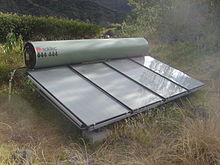Thermosiphon system
As a thermosiphon or Thermosiphonkollektoren refers to plants for heat production from solar energy ( solar thermal systems ), according to the principle of the thermosyphon (like for example, the gravity heating work). The thermosiphon is a passive construction that enables heat to be exchanged by using natural convection in an ideally vertical, closed fluid circuit. The advantage is the avoidance of a conventional pump , which keeps the complexity and costs of a thermosiphon low.
The thermosiphon system in detail
In a thermosiphon system, the different specific gravity of the water at different temperatures is used to drive the water cycle. Due to its lower specific weight, heated water rises to the collecting tank , while at the same time colder water sinks down another line to the heater.
In the collector (4) a liquid - in thermosiphon systems mostly pure service water without additives - is heated by the solar radiation. This rises up in the collector. This has an outlet (3) at the top, which is permanently connected to a hot water tank (2). Heat loss or hot water consumption (1) leads to cooling; the cooled water sinks to the bottom of the storage tank and flows back through its lower outlet into the collector to be heated again there. If the withdrawal valve (1) of the storage tank is opened, the fresh water (5) pushes the hot water out of the storage tank and at the same time refills it.
It is important that the solar storage tank is at least partially above the collector, otherwise there will be no permanent circulation. Often one finds storage and collector as a compact system. The thermosiphon systems work with a direct circuit, i.e. the solar circuit is flowed through by the domestic water (no system separation). This saves not only the pump but also the heat exchanger, which further lowers the system costs. However, this type of construction requires a frost-free installation location, as there is no frost-protected solar fluid in the exposed collector , but drinking water that is exposed to frost. In addition, the solar collector in particular - especially with regard to the choice of material - must be designed to be suitable for drinking water.
This principle is used in warm countries in particular for hot water preparation. The systems are inexpensive and, due to the lack of moving parts, are reliable and require little maintenance. Usual systems have a collector area of 2 m² and can thus supply a 300 liter storage tank with hot water.

